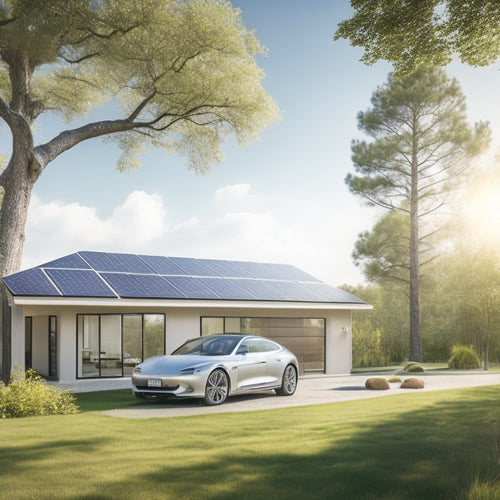
Calculating Cost of 2000 Sq Ft Home System
Share
To accurately calculate the cost of a 2000 sq ft home solar system, you'll need to take into account several factors. First, assess your energy needs by evaluating your daily energy consumption and identifying areas of inefficiency. Then, determine the required panel quantity and quality based on factors like panel efficiency and roof compatibility. Installation costs, labor fees, and permits will add up, so be sure to factor those in. You'll also need to factor in inverter and battery costs, as well as local incentives and tax credits. By carefully evaluating these components, you'll get a clear picture of your total cost - and what it takes to maximize your system's performance and savings.
Key Takeaways
• Calculate daily energy consumption in watt-hours (Wh) or kilowatt-hours (kWh) to determine the required solar panel system size.
• Evaluate the home's energy efficiency to optimize energy usage and reduce the required system size.
• Consider panel efficiency, roof compatibility, and system design to ensure optimal performance and determine the number of panels needed.
• Factor in installation costs, labor fees, and permits, which can account for 10% to 30% of the total system cost.
• Research local incentives and federal tax credits, which can provide up to 30% savings on the total expense, to reduce the overall cost.
System Size and Energy Needs
To accurately size a solar panel system for your 2000 sq ft home, you'll first need to determine your energy needs by calculating your total daily energy consumption in watt-hours (Wh) or kilowatt-hours (kWh).
This involves conducting a thorough load calculation to identify areas of energy inefficiency and opportunities for improvement. By evaluating your home's energy efficiency, you can optimize your energy usage and reduce your reliance on the grid.
Start by making a list of all your appliances, lighting, and HVAC systems, along with their corresponding wattage and usage hours. Multiply the wattage by the usage hours to get the total daily energy consumption in Wh or kWh. This will give you a clear picture of your energy needs and help you determine the required system size.
A precise load calculation guarantees that your solar panel system is adequately sized to meet your energy demands, maximizing your energy independence and savings.
Panel Quantity and Quality Factors
With your energy needs calculated, you're ready to determine the number of solar panels required, which hinges on two critical factors: panel quantity and quality. These two aspects are essential in ensuring your solar power system meets your energy demands.
To calculate the number of panels needed, you'll need to take into account the following key factors:
-
Panel efficiency: The higher the efficiency, the more power each panel produces, reducing the overall number of panels required. High-efficiency panels are ideal for homes with limited roof space.
-
Roof compatibility: The size and shape of your roof will impact the number of panels that can be installed. A larger roof with minimal obstructions can accommodate more panels, while a smaller roof with multiple obstructions may require fewer, higher-efficiency panels.
-
System design and layout: The way your solar panels are arranged on your roof can affect their overall performance. A well-designed system can maximize energy production, reducing the number of panels needed.
Installation Costs and Labor Fees
The overall cost of your solar panel system is greatly influenced by installation costs and labor fees, which can vary from 10% to 20% of the total system cost. These costs can vary considerably depending on factors like your location, system size, and local regulations.
You'll need to take into account permit fees, which can add up quickly, especially if you're installing a large system. These fees can range from $500 to $2,000 or more, depending on your local government's requirements.
When it comes to labor fees, you'll need to decide whether to hire a licensed electrician or a union laborer. Union labor typically comes with a higher price tag, but may offer added benefits like increased quality control and better warranties.
On average, labor fees can range from $2,000 to $5,000 or more, depending on the complexity of the installation and the number of workers required. Be sure to get quotes from multiple installers to find the best combination of price and quality for your solar panel system.
Inverter and Battery Costs Added
Your solar panel system's inverter, which converts DC power to AC, accounts for approximately 10% to 15% of the total system cost, adding $3,000 to $6,000 or more to your overall expense. This important component guarantees a seamless integration with the grid, providing Grid Resilience and allowing you to sell excess energy back to the utility company.
When it comes to Energy Storage, batteries play a significant role in storing excess energy generated by your solar panels during the day for use during the night or during power outages. The cost of batteries can vary greatly, depending on the type, quality, and capacity. Here are some key factors to take into account:
-
Battery Type: Lead-acid, lithium-ion, or flow batteries each have their own strengths and weaknesses, affecting upfront cost and long-term performance.
-
Capacity: The amount of energy storage you need depends on your daily energy usage and backup requirements.
-
Depth of Discharge (DOD): The frequency and depth of battery discharge impact its lifespan and overall cost.
Local Incentives and Tax Credits
You can greatly reduce the cost of your 2000 sq ft home solar system by taking advantage of local incentives and federal tax credits, which can shave off up to 30% of the total expense.
As you calculate the cost of your system, don't overlook the opportunities to slash your expenditure. Municipal rebates, for instance, can provide a substantial discount on your overall cost. These rebates vary by location, but they can be notable, with some municipalities offering up to $2,000 or more.
Additionally, many states offer exemptions on sales tax for solar equipment, which can save you thousands of dollars. For example, some states exempt the sales tax on solar panels, inverters, and other equipment, reducing your upfront cost.
Frequently Asked Questions
Can I Install a Solar Panel System Myself to Save Money?
"If you're considering a DIY solar panel installation, be aware that lack of electrical knowledge and DIY challenges can lead to safety risks and system inefficiencies, potentially negating any cost savings you hoped to achieve."
How Long Does It Take to Install a Solar Panel System?
"Are you ready to harness the power of the sun? You'll need around 3-5 days for a standard installation, factoring in obtaining a Solar Permit and scheduling a Panel Inspection, before you can start generating electricity."
Will Solar Panels Increase My Home's Value?
You'll reap appraisal benefits and resale advantages as solar panels boost your home's value, increasing its desirability and appeal, which can lead to a faster sale and higher sale price when you decide to move.
Are Solar Panels Durable and Resistant to Weather Conditions?
You'll be relieved to know that solar panels are built to withstand harsh weather conditions, boasting impressive weather resistance and climate endurance, ensuring peak performance even in extreme temperatures and weather events.
Can I Add More Solar Panels to My System in the Future?
"Imagine your solar panel system as a flexing muscle, ready to bulk up with more power whenever you want. Yes, you can add more panels in the future, thanks to system expansion capabilities, making future upgrades a breeze."
Related Posts
-

Why Invest in Solar Car Battery Chargers Online?
By investing in a solar car battery charger online, you're not only reducing your reliance on fossil fuels but also o...
-

Top 10 Tips for Buying Car Accessories Online
When purchasing car accessories online, you should take proactive steps to avoid low-quality or incompatible products...
-

5 Ways Bike Sharing Boosts Urban Sustainability
As you explore bike-sharing options, you'll discover five ways it boosts urban sustainability. By reducing congestion...


